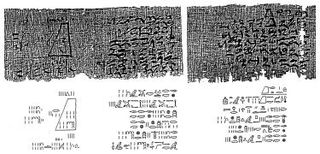 W
WThe Alexandrian World Chronicle or Chronographia Golenischevensis is an anonymous Greek chronicle compiled in Alexandria, recording history from Creation until the year 392 AD. The chronicle survives in the fragments of a c. 6th-century papyrus named the Golenischev papyrus, well known for its examples of early historical illumination.
 W
WThe Eberswalde Hoard or Treasure of Eberswalde is a Bronze Age hoard of 81 gold objects with a total weight of 2.59 kg (83 ozt). The largest prehistoric assembly of gold objects ever found in Germany, it is considered to be one of the most important finds from the Central European Bronze Age. Today, it is in Russia, as part of the group of artifacts and works of art looted from Germany at the end of the Second World War.
 W
WMummy portraits or Fayum mummy portraits are a type of naturalistic painted portrait on wooden boards attached to upper class mummies from Roman Egypt. They belong to the tradition of panel painting, one of the most highly regarded forms of art in the Classical world. The Fayum portraits are the only large body of art from that tradition to have survived. They were formerly, and incorrectly, called Coptic portraits.
 W
WThe Moscow Mathematical Papyrus, also named the Golenishchev Mathematical Papyrus after its first non-Egyptian owner, Egyptologist Vladimir Golenishchev, is an ancient Egyptian mathematical papyrus containing several problems in arithmetic, geometry, and algebra. Golenishchev bought the papyrus in 1892 or 1893 in Thebes. It later entered the collection of the Pushkin State Museum of Fine Arts in Moscow, where it remains today.
 W
WPriam's Treasure is a cache of gold and other artifacts discovered by classical archaeologists Frank Calvert and Heinrich Schliemann at Hissarlik, on the northwestern coast of modern Turkey. The majority of the artifacts are currently in the Pushkin Museum in Moscow.
 W
WThe Story of Wenamun is a literary text written in hieratic in the Late Egyptian language. It is only known from one incomplete copy discovered in 1890 at al-Hibah, Egypt, and subsequently purchased in 1891 in Cairo by the Russian Egyptologist Vladimir Goleniščev. It was found in a jar together with the Onomasticon of Amenope and the Tale of Woe.
 W
WThe Tale of Woe, the Letter of Wermai or Papyrus Moscow 127, is an Egyptian document from the late 20th Dynasty to 22nd Dynasty, part of a collection of three papyri including the Onomasticon of Amenope and the Story of Wenamun.